My name is Deanna McBeath and I've been teaching middle school for ten awesome years! Right now I teach 5th and 6th grade science at the Bernard Zell Anshe Emet Day School in Chicago, IL. I fell in love with science while growing up in Kentucky and Costa Rica, both of which have absolutely stunning natural environments to explore, from Mammoth Cave – the largest underground cave system in the world – to the many volcanoes and rainforests and precolumbian archaeological sites in Central America. Was I a lucky kid, or what? I love all kinds of science, but I get especially fired up when teaching about biodiversity, evolution, and earth science, and my favorite part is getting kids all fired up, too!

Each time my students saw that we'd be watching another Shape of Life clip, they practically cheered! Each one held at least one major "aha moment". In Sponges, my students were amazed that putting these simple organisms through a sieve didn't kill them – the pieces came back together again, still alive – representing the first step towards multicellular life. In Cnidarians, we couldn't believe how all of these seemingly disparate life forms are so closely related, and how nerves and muscles began to evolve. We watched the Flatworms video after observing live flatworms, which completely expanded my students' understanding of these tiny but fascinating hunters. And in Annelids, we just kept having to pause (and exclaim and rewind and re-watch!) because it was blowing our minds how many different cool kinds of worms there are! My kids will never look at an earthworm the same way again.
I hope science teachers everywhere will discover and use Shape of Life resources in their classes. Evolution is the key organizing idea for all of life sciences, and the first question kids always ask is, how did life begin? When they hear that all life forms are related to each other, they want to know – how?! Being able to use Shape of Life to trace some of the earliest developments in the evolution of life on earth is a classroom resource like no other, because it makes these steps explicit and concrete. The in-depth expositions of many amazing groups of organisms, especially ones that are nigh impossible to examine in person in the classroom (like cnidaria), helps students begin to answer these questions.
I am still exploring all of the additional and supplementary resources available on the Shape of Life site, and I'm sure I'll use even more during the next school year. My only recommendation at this point might be to add more in-depth videos about different chordates, from tunicates to all the various vertebrates. Thank you so much for creating such an invaluable treasure trove of amazing animal learning!
















